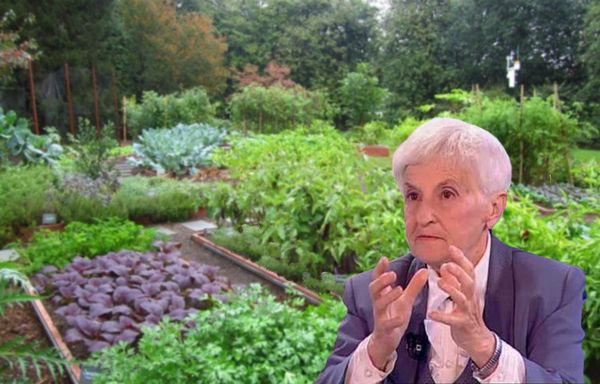Galina Kizima's method is that there is no need to dig the ground, and you plant potatoes in a compost pile above tubers and you grow many healthy potatoes.
Table of contents
Who is Galina Kizima and why is her method so popular
Galina Kizima has written many books about how to grow various plants. Galina Kizima in her method took into account the features of potato growthbased on our own experience of growing potatoes on six acres.
The general essence of technology
The essence of the Kizime planting method is that potatoes are not traditionally planted in the soil, but laid out on the ridge, without digging them, and then cover with hay and all summer weeds are torn out, but without covering themselves the growing stalks of potatoes.
How to plant and grow potatoes according to the method of Kizima
Preparation of planting material
Select healthy, tuberous, egg-sized eggs that are carried by the chicken. Tuber crops begin to prepare 1–1.5 months before planting.
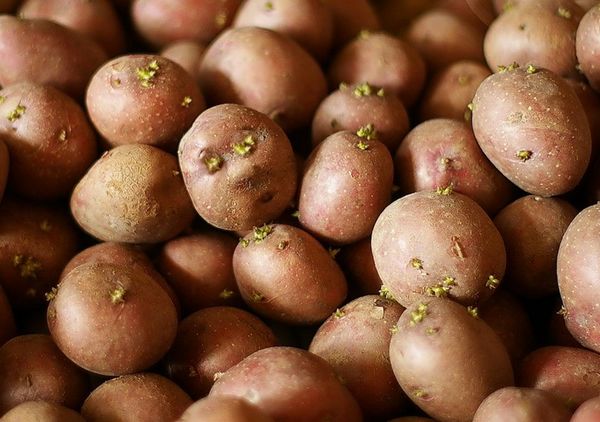
They are washed, put in a basin, filled with clean water, having a temperature +45 degrees, and leave until the time of cooling water. Potassium permanganate is diluted and a little bit gradually poured into the basin, thoroughly mixing water and potassium permanganate, the water should become pink.
Next, leave for 15 min., drain the water, wash the potatoes, dry. This procedure removes bacteria and germs from the rind.
Or, replace the potassium permanganate solution with a phytosporin, diluting a small portion of phytosporin in water so that the solution is almost transparent. Pour the diluted Fitosporin in the basin with tubers and water, leave for 30 min., after dry the potatoes, in this case they do not need to be washed under water.
Tubers put under the rays of the sun for 3 weeksso that they go green. Then poison - solanine will appear in their subcutaneous layer, and the tubers will not be of interest to mice, hares, or other pests.
It is possible to fold the tuber crops into glass jars and place them on the windowsill, turning the jars after a certain amount of time. And you can put a newspaper on the window sill and put tuber crops on it.
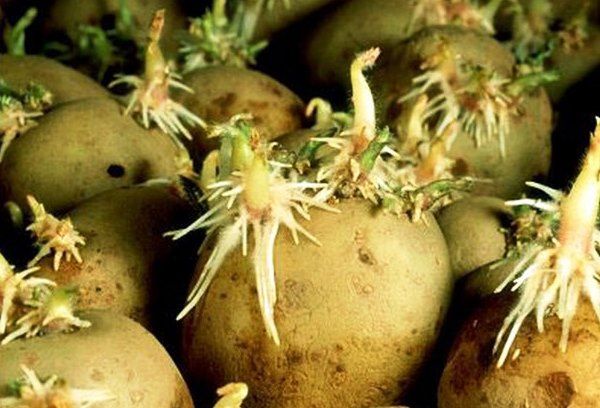
Next, potatoes germinated, they are cleaned in a cardboard box, where they germinate in the dark and warm.
Place them in 1 layer in a cardboard box so that they do not lie flush, cover them with newspapers and place another layer on top, and then another newspaper and a third layer of potatoes. Close the box and place it on a stool near the battery. In order for the eyes to sprout to sprouts having a length of 4-5 cm, it takes about 2-3 weeks.
Step by step potato planting process
It is well known that the tubers do not grow on rhizomes, but on horizontally located shoots growing at the very bottom of the stems, they are called stolons. The stolons do not need soil, they need a blackout.
No need to dig the soil. Sprouted tuber crops spread on virgin soil directly on the weeds.
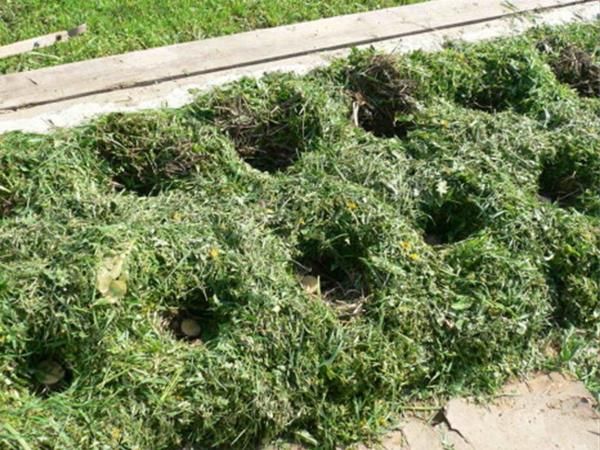
- Make 2 rows, keeping a distance between them 0.4-0.5 m, and arrange potatoes, stepping back 20-25 cm.
- Leave empty 0.2–0.25 m from each of the rows up to the aisle. That is, the width of the beds should be 0.8-1 m, and make the length, what you want. At 1 m you will have 4 tubers in the same row and the same in the other.
- If you have tubers that are smaller than the size of a chicken egg, then put them in one place. 2-3 or you grow too few stems, so you will harvest a small crop.
- Do not put tubers that are larger than the size of a chicken egg, because otherwise you will grow the ground part, and the root system will develop poorly. Because of this, large potatoes cut along, so that there is the same number of sprouts on each of the halves. Let them lie down for 2 days, then the cuts will dry up, after the cuts, powder with ashes so that they do not get bacteria, and then plant.
- The greater the number of stems on the potato, the more abundant the crop, so it is better that the number of sprouts be large. For this on one potato 7 days before landing, a deep transverse incision is required to cut with a knife or peel off the peel in the middle of the tubers with a thin strip in the transverse direction. Then buds will sprout in the lower part of the potato and more stems will appear.
In the central regions, place a very early variety in one row, and a middle-ripening variety in the other. And in the north, plant early variety and medium early.
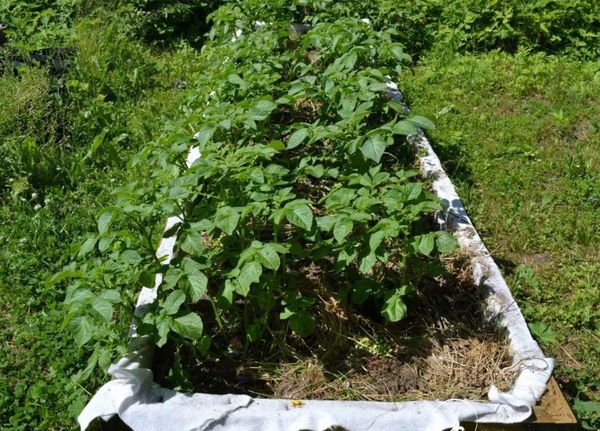
Potato care
Main - protect the beds from returnable frost. Because of this, cover the potatoes with hay, but not with straw. It is not good, because it attracts mice. You can cover the ridges with dry fallen leaves. If you do not have this, then cover it with newspapers or wrapping paper, after cutting it into pieces, crumpling it up. Aisle is no need to cover.
So that all this covers the garden and does not fly away, put a spunboid on top or bags. You can not use the film, as under it planting and weeds begin to sweep.
At the end of the return frosts, remove the spunboid and put on the garden all those materials from which you make a compost pile: weeds, grass. Put it on hay or newspapers, but not on the shoots of potatoes. So do all summer spud young sprouts of potatoes not with soil, but with mowed grass.
So, you do not make mineral fertilizers and manure, do not moisten the plantings, since the compost from weeds is 80% water, and when they rot, it is released and flows to the root system of potatoes.
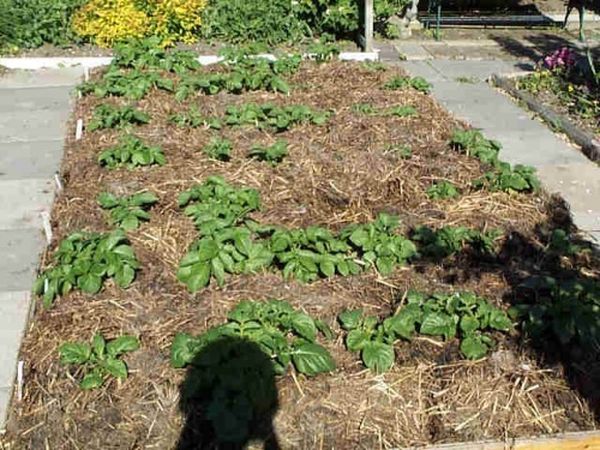
In this case, the weeds that lie under the planting do not grow, but die, because the rays of the sun do not illuminate them. When the potatoes bloom, tuber crops will grow on stolons. Cut the flowers, because their growth is a lot of power and after cutting off the potatoes will put all their strength to the formation of tubers.
If your landing field is too large, then just tear the tops off the bushesas soon as the bushes close up. So your tops will not grow in height and 2–3 additional tubers are formed.
How and when to harvest
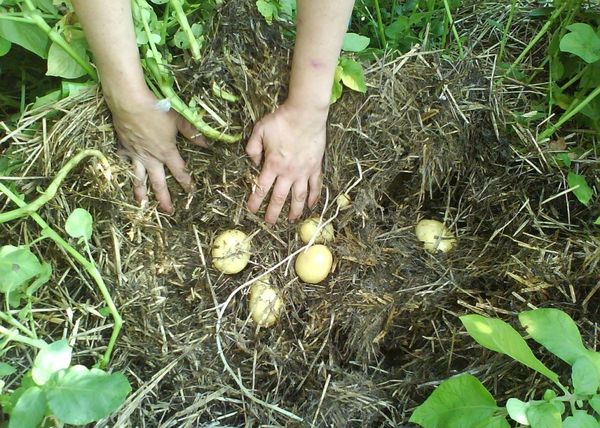
Just slide the compost and pick the largest potatoesand then carefully place the compost in place. With this collection stolons will not be damaged and will grow more tubers.
When you collect all the potatoes from the first row, spread out the tops to dry. In general, it is not advised to put tops in a compost pile from tomatoes and potatoes, as it contains corned beef, but from the sun, precipitation and air, the corned beef will collapse. Leave it all for the winter.
Non-ripened compost has weakly acidic or acidic characteristics; they become neutral when overheated. But the potatoes can be planted in slightly acidic or acidic soil.
